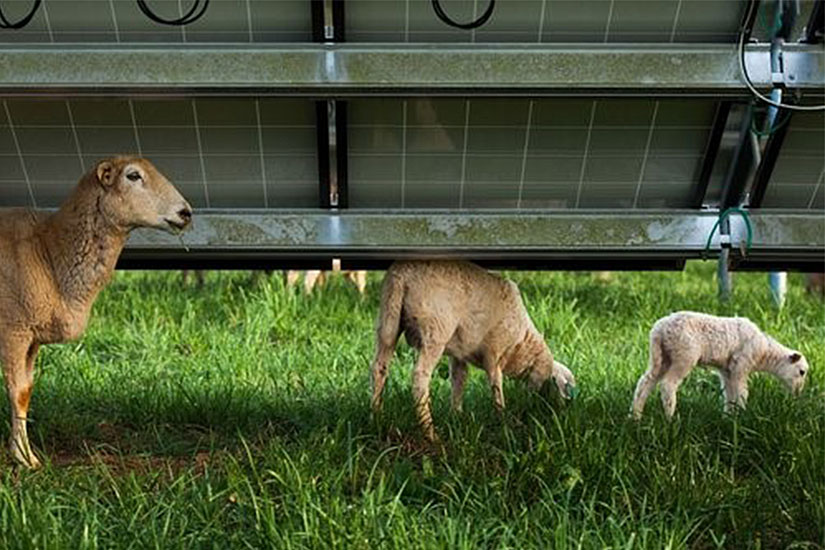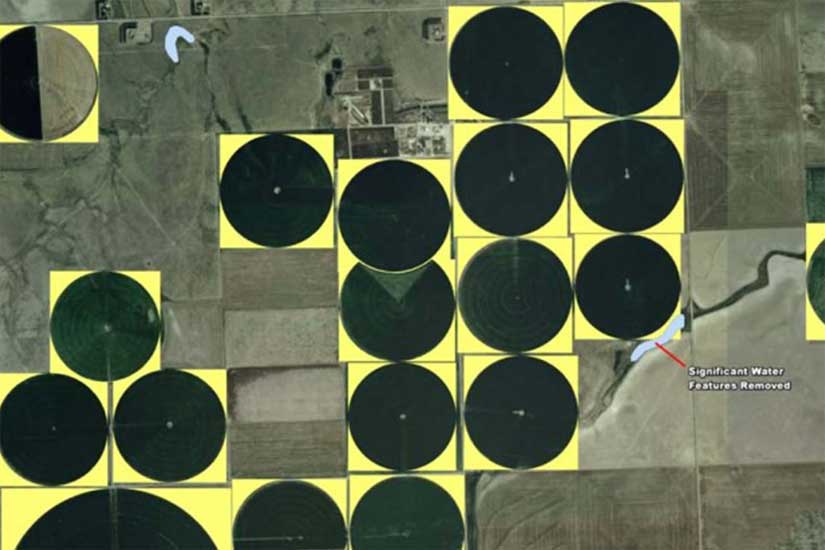Solar Sheep and Voltaic Veggies: Uniting Solar Power and Agriculture
June 6, 2018 by Benjamin Mow
Sheep grazing in a field of solar panels is becoming an increasingly common sight as both farmers and solar developers are starting to experiment with co-locating solar photovoltaic (PV) systems and agriculture. Small-scale, off-grid PV systems located on farm land was one of the first applications of solar power. The arrangement made sense for low-power agricultural needs in locations where running distribution lines was too expensive or not possible. More recently, the idea of solar systems on farm land has expanded to large-scale, grid-connected systems that have vegetation growing around and under the panels and/or livestock grazing on the same parcel of land (see Figure 1).
Figure 1. Grazing Sheep Under Ground-Mounted Solar Installation

Based on the U.S. Department of Energy’s SunShot Vision Study, solar energy capacity in the year 2030 could reach 329 gigawatts (GW), which would require approximately 1.8 million acres of land. While this represents less than 0.1% of total land area in the contiguous United States, there is growing concern over the land use impacts of solar energy development on fertile agricultural land, which can consequently displace farming and food production. As a result, states have started to enact policies aimed at protecting agricultural land from solar development. For instance, Senate Bill No. 943 (which restricts PV facilities of over 2 megawatts on farmland) recently passed the Connecticut General Assembly and counties in North Carolina and Washington have imposed restrictions on large scale solar projects citing concerns over the loss of farmland.
As an alternative to restricting solar installations on agricultural land via policy measures, low-impact solar development and co-location of solar and agriculture is a technique currently being researched that has the potential to alleviate agriculture displacement by allowing solar arrays, vegetation, and livestock to occupy the same land area.
Low-impact solar development can serve a variety of project goals and can be divided into three categories:
- Solar-Centric Design
- Optimized for solar output but keeps low-lying vegetation for ground cover and habitat.
- Vegetation-Centric Design
- Optimized for vegetation growth but allows for solar arrays to be located in areas where vegetation will not be negatively affected (see Figure 2).
- Co-Location Design
- Solar and vegetation configurations are designed jointly for maximum dual output.
All three of these categories can include leaving existing vegetation in place or replacing it with low-growing native vegetation, designing the solar project around natural land contours, and having vegetation that support habitats (for example, pollinator species or livestock). Planning and implementing this vegetation co-location during the initial site preparation can help lower the overall installed cost by an estimated 3%-8% per watt compared to common industry practices in solar development, with cost reductions expected in the following site preparation categories:
- Clearing and grubbing,
- Soil stripping and stockpiling,
- Grading,
- Soil compaction,
- Foundation for vertical supports, and
- Geotechnical investigations.
Figure 2. Farm with Center-Pivoted Irrigation and Vegetation-Centric Design

One concern with growing food crops or natural vegetation under solar modules is the effects of shading and rain run-off. Solar panels cause ground shading throughout the day (although the amount of shading varies based on if the land parcel is directly beneath a panel or between rows) and precipitation tends to drip off the side of the panel that is tilted closer to the ground, both of which can affect plant growth. The NREL technical report Native Vegetation Performance under a Solar PV Array at the National Wind Technology Center systematically studied to what extent plant cover can be re-established and thrive under solar arrays, ultimately concluding that certain types of vegetation can produce an extensive plant cover within a 3-year period. While this study was location specific, the observed effects of shading and general plant growth may be widely applicable to a variety of sites and climates.
An additional solar and agriculture co-location technique is to keep a herd of sheep or other livestock within the enclosure of a ground-mounted PV system to help control vegetation height. Doing so can significantly reduce operation costs for solar developers. A spokesperson for Duke Energy, one of the largest electric utility companies in the United States, noted that apart from the lease of the land, vegetation management (i.e., lawnmowing) is the primary operating expense at their solar facilities. A mutually beneficial partnership can be established between sheep farmers and solar developers, where the developers provide grazing land at the site of their solar development and the sheep provide low-cost vegetation control. Multiple sheep farming companies have been founded on this principle and can help provide a key source of revenue for 21st-century farmers. Other types of animals have been tested for solar vegetation management, but sheep have often proven to be the best tenants of the land. Horses can be picky about what they eat, cows are large and require a lot of space, and goats tend to chew on wires and climb on panels.
Co-location of solar and agriculture can have multiple benefits for both land owners and solar developers, as highlighted in the table below.
|
Benefits to Land Owners |
Benefits to Solar Developers |
|---|---|
|
Self-generation of electricity and reduced energy bills |
Reductions in site preparation and installation costs |
|
Control of wind and soil erosion |
Reductions in operation and maintenance costs |
|
Compatible with grazing activities, provides shade and cover for livestock |
Reduced need for dust suppression |
|
Market opportunity for shade tolerant crops |
Decreased permitting time |
|
Improved habitat for pollinator species |
Increased solar production from cooler air zone created under modules |
|
|
Reduction in environmental mitigation investments |
Table adapted from Overview of opportunities for co-location of agriculture and solar PV (NREL).
With research and pilot projects continuing to develop in the field of co-locating solar with agriculture, expect to see some solar panels in a pasture near you!
For information about solar technical assistance, visit the Solar Technical Assistance Team website or email stat@nrel.gov.
Share

